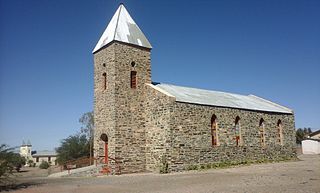
Windhoek is the capital and largest city of Namibia. It is located in central Namibia in the Khomas Highland plateau area, at around 1,700 m (5,600 ft) above sea level, almost exactly at the country's geographical centre. The population of Windhoek, which was 486,169 in 2023, is constantly growing due to a continued migration from other regions in Namibia.

Gobabis is a town in eastern Namibia. It is the regional capital of the Omaheke Region, and the district capital of the Gobabis electoral constituency. Gobabis is situated 200 km (120 mi) down the B6 motorway from Windhoek to Botswana. The town is 113 km (70 mi) from the Buitepos border post with Botswana, and serves as an important link to South Africa on the tarred Trans-Kalahari Highway. Gobabis is in the heart of the cattle farming area. In fact Gobabis is so proud of its cattle farming that a statue of a large Brahman bull with the inscription "Cattle Country" greets visitors to the town. Gobabis also has its own local airport.

Berseba is a village in the ǁKaras Region of southern Namibia and the district capital of the Berseba electoral constituency. It is situated 100 km (62 mi) north-west of Keetmanshoop near the Brukkaros Mountain, a famous tourist destination.

Bethanie is a village in the ǁKaras Region of southern Namibia. It is one of the oldest settlements in the country. Bethanie is situated on the C14 road between Goageb and Walvis Bay, 100 km west of Keetmanshoop. It has a population of about 2,000.

The Oorlam or Orlam people are a subtribe of the Nama people, largely assimilated after their migration from the Cape Colony to Namaqualand and Damaraland.
Gibeon is a village in Gibeon Constituency in the Hardap Region of Namibia.

Aroab is a village with a population of approximately 5,000 in the ǁKaras Region of southern Namibia. It is situated about 170 kilometres (110 mi) south-east of Keetmanshoop on the edge of the Kalahari desert; the average annual rainfall is about 150–200 mm. Aroab is the district centre of the Keetmanshoop Rural electoral constituency.

Aminuis Constituency is an electoral constituency in the Omaheke Region of Namibia. It had 12,343 inhabitants in 2004 and 7,847 registered voters in 2020. The district capital is the settlement of Aminuis. The constituency forms part of the border between Namibia and Botswana.

Jonker Afrikaner was the fourth Captain of the Orlam in South West Africa, succeeding his father, Jager Afrikaner, in 1823. Soon after becoming Kaptein, he left his father's settlement at Blydeverwacht with three brothers and some 300 followers and relocated to the area that is today central Namibia. From 1825 onwards he and his council played a dominant political role in Damaraland and Namaland, creating a de facto state.
Hermann Heinrich Vedder was a German missionary, linguist, ethnologist and historian. Originally a silk weaver, he received missionary training by the Rhenish Missionary Society in Barmen between 1894 and 1903, whereafter he was sent to German South West Africa in 1905 and worked as a missionary and teacher trainer until his retirement, first for the black workers and prisoners-of-war in Swakopmund, then at the small mission station Gaub in the Otavi Mountains, and from 1922 onwards in Okahandja, where he taught at the Augustineum school.

Aranos is a town in the Hardap Region of central Namibia, situated in the Nossob River basin in the Kalahari Desert.

Witvlei is a village in the Okarukambe Constituency in the Omaheke Region of central-eastern Namibia. It is situated on the B6 150 kilometres (93 mi) from Windhoek on the way to Gobabis. It is known for producing high quality meat.
Andreas Lambert, also known as Andries Lambert, was the second Kaptein of the Kaiǀkhauan, a subtribe of the Orlam, in the eastern area of South-West Africa, today's Namibia.
Amraal Lambert, Nama name: ǂGaiǀnub, was the first Captain of the Kaiǀkhauan, a subtribe of the Orlam, in the eastern area of Namaland, today's Namibia.

Franz Heinrich Kleinschmidt (1812–1864) was a German missionary and linguist who worked in southern Africa, now in the region of Namibia. He founded the missionary station and town of Rehoboth and together with Carl Hugo Hahn set up the first Rhenish mission station to the Herero people in Gross Barmen. Kleinschmidt is known for his scientific work on the Nama language.

Reverend Johann Heinrich Schmelen, born Johann Hinrich Schmelen was a German missionary and linguist who worked in South Africa and South-West Africa. Traveling through the area of today's northern South Africa and central and southern Namibia he founded the mission stations at Bethanie and Steinkopf and discovered the natural harbour at Walvis Bay. Together with his wife Zara he translated parts of the Bible into Khoekhoegowab (Damara/Nama) and published a dictionary.
The Red Nation is the main subtribe of the Nama people in Namibia and the oldest Nama group speaking Khoekhoegowab, the language often called Damara/Nama.

Manasse ǃNoreseb Gamab was the thirteenth Kaptein of the Khaiǁkhaun, a subtribe of the Nama people in Namibia, between 1880 and 1905. At the start of Imperial Germany's colonisation of South-West Africa, Manasse was one of the most powerful leaders in the area.

Aminuis is a cluster of small settlements in the remote eastern part of the Omaheke Region of Namibia, located about 500 km east of Windhoek. It is the district capital of the Aminuis electoral constituency.
Cupido Witbooi, variations: Kido and Kiwitti Witbooi, Nama name: ǂA-ǁêib ǃGâmemab, was the first Kaptein of the ǀKhowesin, a subtribe of the Orlam of South-West Africa, present-day Namibia.















